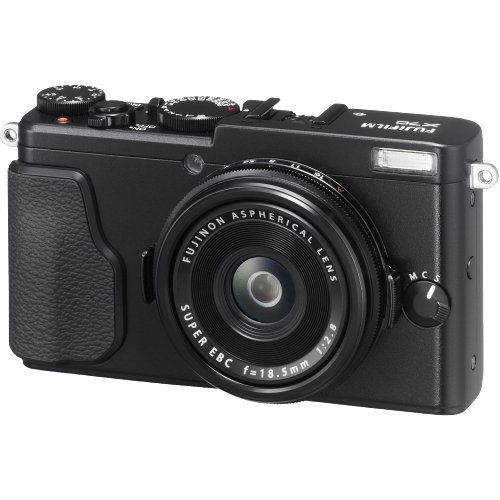Fujifilm X100T vs X70 Comparison
Fujifilm X100T

Fujifilm X70

The Fujifilm X100T and Fujifilm X70 both scored 53/100 in our evaluation, making them equally competitive. These mirrorless and compact cameras were announced in 2015 and 2016, respectively, with the X100T priced at $1,300 and the X70 at $799. They share similarities such as camera type and announcement year.
The X100T has a larger size (127 x 74 x 52mm) and weighs more (440g) compared to the X70’s smaller size (113 x 64 x 44mm) and lighter weight (340g). This makes the X100T more suitable for those who prefer a more substantial camera, while the X70 is ideal for those seeking a more compact and lightweight option. Considering their individual characteristics, both cameras cater to different preferences and needs, making it difficult to declare a clear winner.
Fujifilm X100T vs X70 Overview and Optics
The Fujifilm X100T and the Fujifilm X70 both receive a score of 54/100 for their optics, indicating that they have similar capabilities in this area. They share several specifications, such as 16-megapixel resolution, CMOS sensor type, EXR Processor II, APS-C sensor size, and a fixed lens mount, which means that neither camera allows for interchangeable lenses. Additionally, both cameras lack image stabilization.
Despite having the same score, the Fujifilm X100T has a shooting speed of 6 frames per second, while the Fujifilm X70 boasts a slightly faster speed of 8 frames per second. This advantage makes the X70 more suitable for capturing fast-moving subjects or taking continuous shots.
On the other hand, the Fujifilm X100T has its own strengths. Although not explicitly mentioned in the specifications, the X100T is known for its hybrid viewfinder, which combines the features of an optical viewfinder and an electronic viewfinder. This unique feature provides photographers with the option to switch between the two viewfinder types, catering to different shooting preferences and conditions.
Taking these factors into consideration, the Fujifilm X100T and X70 have comparable optical capabilities, with the X70 having an edge in shooting speed and the X100T offering a versatile viewfinder. Ultimately, the choice between these two cameras will depend on the specific needs and preferences of the photographer.
Fujifilm X100T vs X70 Video Performance
The Fujifilm X100T and Fujifilm X70 both have a video score of 70/100, indicating that their video capabilities are on par with each other. Both cameras offer Full HD video resolution, with maximum video dimensions of 1920 x 1080 and a maximum video frame rate of 60fps. Additionally, both cameras have built-in time-lapse functionality.
In terms of common video specs, the X100T and X70 are equal. Neither camera outperforms the other in this regard. Since both cameras have the same video score, it can be concluded that they provide similar video performance and quality.
However, there may be other features or specs not covered by the video score that could give one camera an advantage over the other. It is essential to consider these factors when deciding which camera best suits your needs.
Despite their equal video scores, it is possible that the X100T or X70 might have specific advantages in certain situations. For instance, one camera might have better low-light performance, autofocus capabilities, or audio quality. These factors should also be taken into account when making a decision.
In the end, both the Fujifilm X100T and X70 have comparable video capabilities, as evidenced by their identical scores. Users should consider other factors and personal preferences when choosing between these two cameras.
Fujifilm X100T vs X70 Features and Benefits
The Fujifilm X100T wins in the features comparison with a score of 58/100, while the Fujifilm X70 scores 57/100. Both cameras share some common specifications, including a 3-inch screen, flip screen, no GPS, and WIFI connectivity.
The X100T outperforms the X70 in terms of screen resolution, with 2,360,000 dots compared to the X70’s 1,040,000 dots. This higher resolution provides a clearer and sharper display for better image preview and menu navigation. Additionally, the X100T includes Bluetooth connectivity, which is absent in the X70. This feature enables seamless pairing with compatible devices for easy photo sharing and remote control functions.
On the other hand, the X70 has an advantage over the X100T with its touchscreen capability. This allows for more intuitive control and quicker access to settings adjustments, making it user-friendly for those who prefer touchscreen interfaces.
To conclude, the Fujifilm X100T has a slight edge over the X70 in terms of features, mainly due to its higher screen resolution and Bluetooth connectivity. However, the X70 offers a touchscreen interface that some users may find more convenient. Ultimately, the choice between these two cameras depends on individual preferences and priorities when it comes to features and usability.
Fujifilm X100T vs X70 Storage and Battery
The Fujifilm X100T and the Fujifilm X70 both have a storage and battery score of 21/100, showing no difference in their performance in this aspect. They share several common specifications, including having one memory card slot each, accepting SD / SDHC / SDXC memory cards, and providing 330 shots of battery life. Both cameras use the Lithium-Ion NP-95 battery type and do not have USB charging capabilities.
Since both cameras have identical storage and battery scores, neither can be considered better than the other in this regard. They offer the same level of performance in terms of memory card compatibility, battery life, and charging options. Therefore, when comparing these two cameras based on storage and battery, it is a tie, with neither model outperforming the other.
Fujifilm X100T vs X70 – Our Verdict
Are you still undecided about which camera is right for you? Have a look at these popular comparisons that feature the Fujifilm X100T or the Fujifilm X70:

